Guides & best practices
View all articlesLead generation funnel: How to attract and convert better leads

The ideal customer filling out your forms, conversion rates that soar – no, you’re not dreaming. Effective lead generation funnels make your conversion dreams a reality.
Successful lead generation funnels draw visitor engagement and interactions, provide integrated tools to streamline processes, reveal actionable insights, and – best of all – prevent churn. In this article, we cover what a lead generation funnel is, how to build one, and strategies for optimization.
Let’s get started.
What is a lead generation funnel?
A lead generation funnel filters potential customers (leads) to your business. They’re tools designed to convert website visitors into engaged and informed prospects or paying customers.
Think of a lead gen funnel like a train station:
A lead generation form is where potential passengers board your train
Each field in the form represents a ticket check, or a stop to ensure the right travelers are on board
If the process is smooth and the requirements are simple – like asking for a name and email – more people are likely to hop on.
But if the station demands too much – like multiple forms of ID or an extensive questionnaire – many passengers might decide to skip the train altogether.
The goal is to make boarding easy and inviting, while still ensuring you're bringing the right passengers along on your journey.
Let’s dive into what that looks like a little further.
🚂choo choo
Stages of a lead generation funnel
There are five main stages of a lead generation funnel. The stages go from wider-reaching to finer-keeping, as per the shape of a funnel.
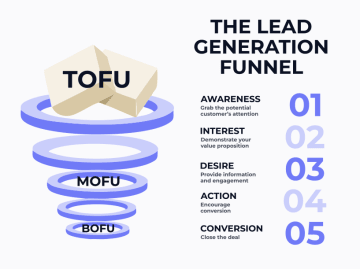
The lead generation funnel
The five main stages of the lead generation funnel:
Awareness: Grab the potential customer’s attention through social media posts, content marketing, and other tactics to reach your target audience
Interest: Demonstrate your value proposition through marketing channels, social media, and on your landing page
Desire: Provide information and content for the potential customer to interact with, showing how you provide a solution to their particular problem (pain point)
Action: Encourage conversion through trials, consultations, or demos
Conversion: Use effective calls to action (CTAs) and complete the lead generation process
The top of the funnel (known as TOFU, but not the one you eat) represents the general public you’re meeting at the awareness stage. The lead generation conversion funnel then moves down to mid-funnel, or MOFU, where the customer journey is marked with interest and interaction. At this stage, you have the potential lead’s attention, and effective use of your marketing channels is key to moving them to the next stage.
And what’s the next stage, you ask? The holy grail of the sales lead funnel. Once you’ve reached the bottom of the funnel, or BOFU, you interact with your ideal customer and are just steps away from conversion.
Sounds great, right? Now, how do you do it?
How to build a lead generation funnel in 5 steps
It’s the 21st century. Pigs don’t fly (yet), but at least you don’t need a bunch of coding knowledge to create an effective lead magnet. Here are five simple steps to get you started.
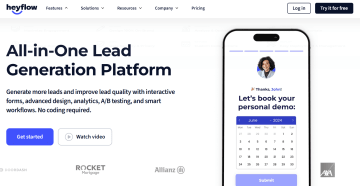
Heyflow’s all-in-one lead generation platform; Source: Heyflow
1. Identify your target audience
Your target audience is one of your main bases for reference. Your initial questions are: who is your lead magnet for, and what problem are they trying to solve?
By identifying your target audience and their pain point, you can relate to prospective clients and offer solutions.
For example, let’s say you’re a real estate company. You need to design a lead generation funnel that appeals to your target audience, offering qualifying questions that encourage them to begin a customer journey specific to their needs.
Ask qualifying questions like:
What type of house is your property?
What's the total size of the property that belongs to your house?
What condition is your house in?
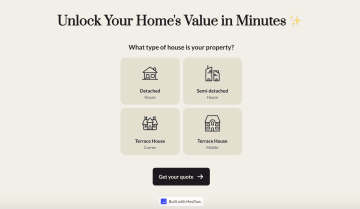
A lead generation funnel that caters directly to the target audience for a real estate company; Source: Heyflow
2. Create your lead magnet
After you’ve identified your target audience, you need to create a lead magnet to generate awareness and attract them to your business.
A lead magnet is an incentive offered to potential customers in exchange for their contact information. It's designed to attract leads by providing something valuable upfront.
Here are some examples of lead magnets:
Educational content like guides, checklists, and cheat sheets
Exclusive events like webinars, free trials, and courses available for a limited time
Promotions like discounts, free shipping, and free samples
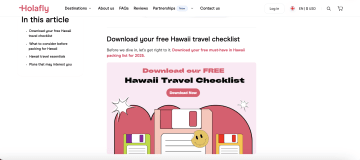
Create a lead magnet that’s useful for the customer; Source: Holafly
Since you already know your potential customers and their pain points, you can create relevant lead magnet content that appeals to them. The lead magnet example above from eSIM company, Holafly, appeals to travelers by offering a free downloadable travel checklist.
3. Design landing pages and forms
Support your marketing and sales teams’ efforts with an attractive landing page and an effective lead capture form.
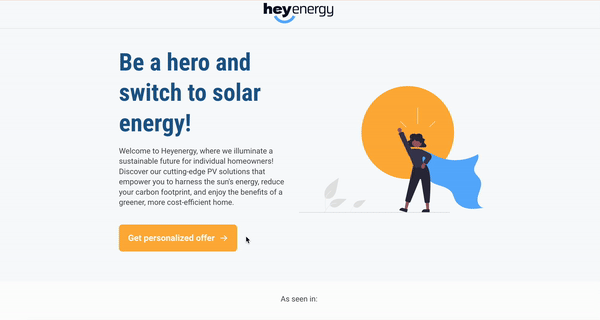
Successful landing page template; Source: Heyflow
A successful lead generation landing page is attractive, easy to navigate, and includes a lead capture form.
Looks great… and complicated. Nope! No-code platforms like Heyflow empower businesses to create interactive forms and landing pages for your lead generation funnel without the need for coding. They’re designed with the user in mind, helping to simplify the sales process.
4. Develop a follow-up email sequence
Once you’ve utilized your lead magnets and acquired contact information from qualified leads, it’s up to you to follow up.
Through seamless integration, platforms like Heyflow allow you to enhance lead engagement and streamline communication through customized, automatically generated emails.
The timing and structure of these emails play a crucial role in keeping leads engaged and moving them through the funnel. Ideally, you should implement a series of emails instead of relying on a single follow-up. Here's how to approach it:
Immediate response: Send a thank-you email when the lead takes action (e.g., the customer downloads a lead magnet or fills out a form). This email should confirm their action, provide any promised resources, and offer additional value or next steps.
Follow up within 24–48 hours: Reinforce your value proposition with a personalized message addressing the lead’s specific needs or interests. This could include testimonials, case studies, or success stories that build trust.
Ongoing engagement: Send additional emails over the next few days or weeks, timed strategically to maintain engagement without overwhelming the lead. These emails can share educational content, highlight key features of your offering, or encourage further interaction (e.g., scheduling a demo or consultation).
The emails should:
Provide value-driven content relevant to the lead’s problem or interest
Maintain a conversational tone that reflects your brand personality
Include clear calls-to-action (CTAs) to guide the lead toward the next step, such as booking a call or exploring more resources
Personalized and timely emails are an essential part of the lead generation conversion funnel as they:
Demonstrate a commitment to customer satisfaction
Set you apart from the competition
Build trust and accountability
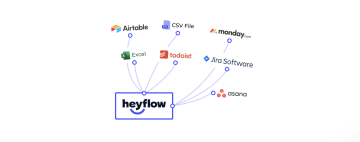
Seamless integrations streamline your organization’s communication; Source: Heyflow
5. Set up tracking and analytics
The success of your lead generation funnel doesn’t have to be a guessing game.
Once you’ve moved through the first four steps of how to build a lead generation funnel, apply tracking and analytics to optimize lead generation.
Heyflow offers built-in analytics to provide insights into funnel performance, identify drop-off points in the sales process, and monitor conversion rates.
Use these insights to make data-driven decisions, such as:
Adjust targeting strategies
Tweak your funnel design
Refine messaging
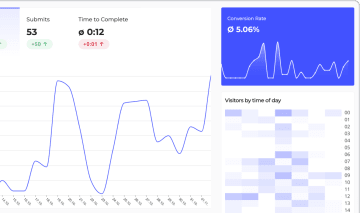
Heyflow’s built-in analytics tab; Source: Heyflow
____________________________
Transform your lead generation strategy today
Experience the power of Heyflow's intuitive drag-and-drop builder to create interactive, on-brand flows that captivate your audience
____________________________
Strategies to optimize your lead generation conversion funnel
Generating leads doesn’t happen by accident. Sales funnels are optimized with best practices. Use the following best lead generation tools to attract more leads, drive traffic, and leverage lead capture forms.
Let’s have a look into what those tools are.
A/B testing tools
A/B testing enables you to optimize lead generation through data-driven decision-making. Test key elements in the sales process like headlines, CTAs, or navigation. By identifying what resonates best with your audience, you create a smoother, more engaging user experience.
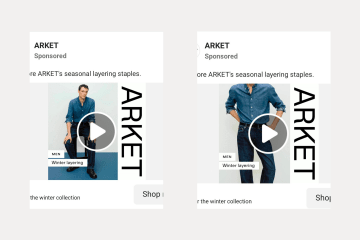
A/B testing social media ads by ARKET; Source: Meta, Facebook Ads
ARKET, a fashion and lifestyle brand, runs a variety of social media ads to test on their target audience. Lead generation industry best practices recommend you isolate one factor to measure and optimize from there. Here, the hero image on this lead magnet is going through paid advertising A/B testing.
Personalization
A great way to add credibility to your lead generation funnel is to include personalization along the way. Everyone likes to feel cared about.
Ways to personalize your lead generation funnel:
Add social social proof to your landing page, like quotes and testimonials
Customize automated responses and emails with customer’s details
Set up reminders for webinars, discounts, or courses
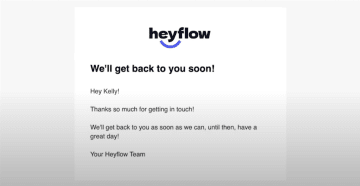
Customized automated email response as part of a lead gen funnel; Source: Heyflow
Retargeting ads
Another strategy to optimize your lead generation conversion funnel is to re-engage potential leads who have previously interacted with your brand but haven't yet converted. By leveraging marketing efforts like retargeted Google Ads directed at these “warm leads,” you can bring them back into the conversion funnel – and further along the sales process.
Analyze key metrics
Analyzing data provides actionable insights into how your sales funnel performs at each stage. You can identify bottlenecks or areas where potential leads drop off by closely monitoring metrics such as conversion rates, bounce rates, and time-on-page.
Sound very… numbery? Don't worry; Heyflow makes metrics easy.
You can get valuable insights on user behavior through the built-in Heyflow analytics tab. Learn where in your flow visitors are dropping off. Analyze your visitors by device or the conversion rate development over time.
All the data you need to optimize your lead generation funnel – no additional setup needed!
_________________________
Elevate your conversion rates with Heyflow
Design personalized user experiences effortlessly and watch your website visitors turn into loyal customers
_________________________
Get your lead generation funnel flowing
Incorporating a well-designed lead generation funnel ensures you're not just attracting visitors but are effectively marketing to qualified leads.
By optimizing each stage of the funnel, you engage prospects with targeted strategies that address their needs and guide them toward conversion. Let the good forms flow with Heyflow and make turning prospects into loyal customers easier.



